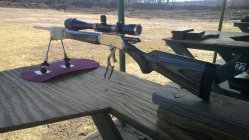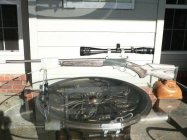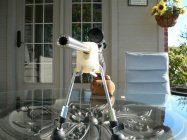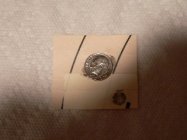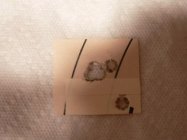The directions for the RCBS 2die set says all cases should be trimmed to the same length if your going to use a crimp. If so, I assume I need to trim all, to the length of the shortest case? And, is there a minimum case length? I measured all the case lengths, none are to maximum allowed length. The trim length states 1.910 max is 1.920 some cases are a little below 1.900 in length. This is my first dealings with the 35 Remington all cases are (fired) cases. All input will be greatly appreciated! 
You are using an out of date browser. It may not display this or other websites correctly.
You should upgrade or use an alternative browser.
You should upgrade or use an alternative browser.
Marlin 336 35 remington crimping questions
- Thread starter p5200
- Start date
rockhound78
Silver $$ Contributor
I would trim to 1.900" and those too short, just seperate and use them singly loaded, not from the tube. That way you won't have to crimp the short cases.
ben-o
Silver $$ Contributor
35 rem is not a straight wall case. You can definitely use a 2 die set like any other bottleneck case.Is it an absolute must, to have a 3rd expanding die since 35 remington is considered a straight walled case? Or, can and has it been done with the RCBS 2 die set? Thanks! Or, is the expander die used mainly, for loading lead bullits?
wboggs
Gold $$ Contributor
I like the Lee factory crimp for your intended use. They are cheap and do a good job. Try one.The directions for the RCBS 2die set says all cases should be trimmed to the same length if your going to use a crimp. If so, I assume I need to trim all, to the length of the shortest case? And, is there a minimum case length? I measured all the case lengths, none are to maximum allowed length. The trim length states 1.910 max is 1.920 some cases are a little below 1.900 in length. This is my first dealings with the 35 Remington all cases are (fired) cases. All input will be greatly appreciated!
PhilC
Silver $$ Contributor
Absolutely! For as hard as it is to locate 35 Rem brass I wouldn't worry to much about a few thousandths difference in case length. If the majority of your brass is within a couple thousandths, don't trim them to the shortest cases.35 rem is not a straight wall case. You can definitely use a 2 die set like any other bottleneck case.
Another tip, do not, full length size your brass. You want to size just enough so a case will chamber without forcing it and lock your die at that setting. Call it a modified neck size if you want and the brass will last longer this way.
I load and shoot a '59 Marlin ADL in 35 Rem.
P5200-The directions for the RCBS 2die set says all cases should be trimmed to the same length if your going to use a crimp. If so, I assume I need to trim all, to the length of the shortest case? And, is there a minimum case length? I measured all the case lengths, none are to maximum allowed length. The trim length states 1.910 max is 1.920 some cases are a little below 1.900 in length. This is my first dealings with the 35 Remington all cases are (fired) cases. All input will be greatly appreciated!
Howdy !
IMHO -
There are 5 different ways to get into trouble, when loading/re-loading the .35 Remington; and the first 3 are..... be over-zealous in use of the FL size die...which can result in cartridges that won't fire. One thing I have done with .35 Rem cases destined for use in my
M-336 XLR ... is forego FL sizing, and just do neck sizing. And for this... a LEE " collet neck size die excels ! I haven't FL sized any of my rifle brass for 40+ years ( I do not shoot auto-loaders, and am not a particularly high volume shooter ). I myself have not yet had any cases sized by this method, that failed to feed, chamber, fire; or extract. Not negatively affecting the case by doing unecessary sizing allows for more predictable adjustments of the LEE collet NS die; as the case shoulder interfaces with the inside matching shoulder of the die collet.
I recommend you run the cases right @ 1.920" case oal spec. If your clutch of fired.35Rem cases have overall lengths of various measurements, and some/ many are considerably
" short " of 1.920" oal; it is likely asking too much to expect repeat firings to " grow " the cases back to 1.920". If just .002" or .003" short, stuff like that can be grown in length by just a few continued firings. Get those to 1.920", and then start case oal trimming.
Otherwise....consider sourcing cases that are not excessively short from the git go.
I attach value to doing at least a rudimentary outside neck " turning ", even if it is a skim trim that simply removes " orange peel " texture from the case' outside necks. Remington-brand .35 Remington cases I have received have no more than .012" neck wall thickness, and many even less.
I recommend you use a primer pocket uniformer on all primer pockets after a couple of firings ( for brass that has a flat primer pocket upper surface ). That allows the case head to stabilize in your rifle's chamber/bolt head. I also recommend you do inside flash hole deburring, and gage all flash hole for under or over size diameter; on all cases.
You're in luck, because .35 Remington cases capacity and common bullet weights place potential powder choices squarely in the zone populated with proven benchrest powders.
* I use my M-336 XLR over-the-bench, for accuracy work and not in the field; so... I don't use a crimp. If I did crimp... I would try using a .380 ACP taper crimp die; because I run .010" neck wall thickness on my cases.
Note: 2 pics below show a 5-shot 100yd group I shot with my M-336 XLR .35Remington.
I was using a windflag, and first 3 shots grouped closely. I held outside the group for the 4th and 5th shots...based o n what I THOUGHT the flag was showing me. AAackkk !!
Well..... that's all how I do .35 Remington. But hey.... what do I know ?!
Attachments
It looks like I am the outcast on this thread as I load for THE .35 Remington, a Remington Model 8.
I haven't loaded any in a few years but never experienced any issues with my brass.
Most of, well probably all of my loads started with factory once fired brass or new brass, some have probably been loaded several times.
We do have a Remington model 141 pump in .35 Rem. but have not shot it yet.
I have also loaded all of the other Remington cartridges, for these rifles, the .32, 30, & .25 Remington.
I haven't loaded any in a few years but never experienced any issues with my brass.
Most of, well probably all of my loads started with factory once fired brass or new brass, some have probably been loaded several times.
We do have a Remington model 141 pump in .35 Rem. but have not shot it yet.
I have also loaded all of the other Remington cartridges, for these rifles, the .32, 30, & .25 Remington.
wboggs
Gold $$ Contributor
That 141 pump is one sweet shooting rifle. 200gr CL really hammers deerIt looks like I am the outcast on this thread as I load for THE .35 Remington, a Remington Model 8.
I haven't loaded any in a few years but never experienced any issues with my brass.
Most of, well probably all of my loads started with factory once fired brass or new brass, some have probably been loaded several times.
We do have a Remington model 141 pump in .35 Rem. but have not shot it yet.
I have also loaded all of the other Remington cartridges, for these rifles, the .32, 30, & .25 Remington.
We also have a Pre-model 14 in .32 Remington. Unfortunately, the ,32 can be too long depending on bullet. The Speer bullet works just fine, the Hornady is too long if you use the cannelure.That 141 pump is one sweet shooting rifle. 200gr CL really hammers deer
The .35 shouldn't be a problem because I think the oal is shorter than the .25, 30, and .32 Rem.
wboggs
Gold $$ Contributor
Makes sense, different case. I knew an old timer in Chiefland, FL who hunted bears for the govt. I was surprised that he used a .25 Rem pump with full jacketed bullets. Used dogs and was a crack shot.We also have a Pre-model 14 in .32 Remington. Unfortunately, the ,32 can be too long depending on bullet. The Speer bullet works just fine, the Hornady is too long if you use the cannelure.
The .35 shouldn't be a problem because I think the oal is shorter than the .25, 30, and .32 Rem.
Similar threads
- Replies
- 2
- Views
- 160
- Replies
- 29
- Views
- 13,944
Upgrades & Donations
This Forum's expenses are primarily paid by member contributions. You can upgrade your Forum membership in seconds. Gold and Silver members get unlimited FREE classifieds for one year. Gold members can upload custom avatars.

Click Upgrade Membership Button ABOVE to get Gold or Silver Status.
You can also donate any amount, large or small, with the button below. Include your Forum Name in the PayPal Notes field.
To DONATE by CHECK, or make a recurring donation, CLICK HERE to learn how.

Click Upgrade Membership Button ABOVE to get Gold or Silver Status.
You can also donate any amount, large or small, with the button below. Include your Forum Name in the PayPal Notes field.
To DONATE by CHECK, or make a recurring donation, CLICK HERE to learn how.










